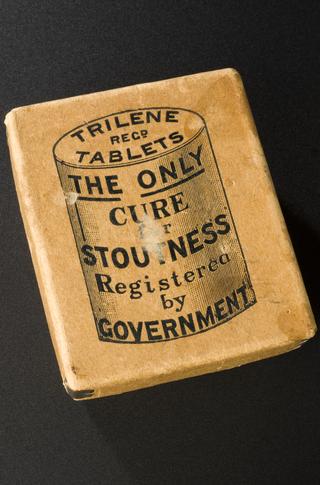
Box for 'Trilene' tablets, Europe, 1801-1900
1801-1900
Carton for "Trilene" tablets
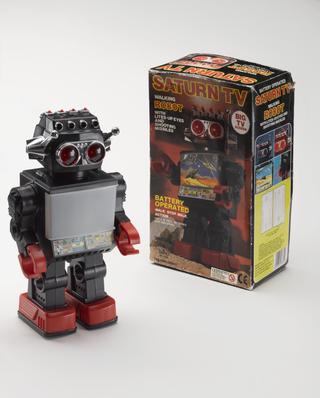
Saturn TV Robot with box packaging and accessories
1984
Saturn TV Robot with box packaging and accessories, manufactured in Hong Kong, 1984
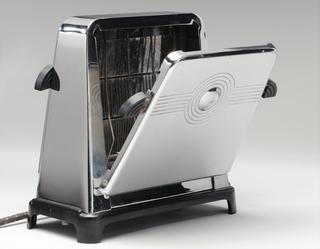
Electric toaster, about 1930
1920-1940
small two slice electric toaster made of aluminium, with base and lever handles made of phenol formaldehyde, with flex but no plug, made in England by the General Electric Company Ltd of England, 1920-1940

Thumbscrew, France, 1601-1850
1601-1850
Thumbscrew, steel, probably French, 1601-1850

Aveling and Porter steam traction engine
circa 1871
Aveling and Porter steam traction engine, by Aveling and Porter Ltd., Rochester, Kent, England, 1870-1872.
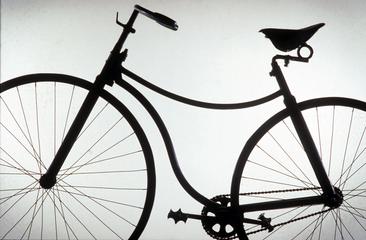
Rover 'Safety' Bicycle, 1885
1885
Rover safety bicycle of 1885 (first embodiment of the modern arrangement), with saddle re-made by Brooks in 1961.
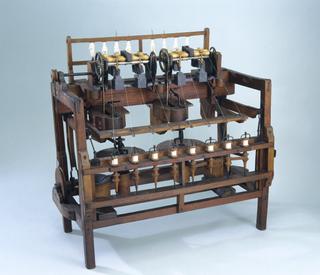
Arkwright's Water Frame, 1775
1775
Improved spinning machine (water frame), by Sir Richard Arkwright, England, 1775.
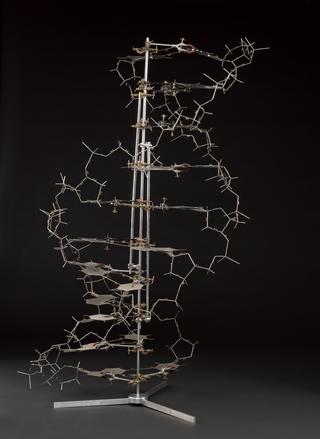
Crick and Watson's DNA Molecular Model
1953
Reconstruction of the double helix model of DNA, originally by Francis Crick and James Watson, 1953, using some of the original metal plates, made by Farooq Hussain at King's College London, 1977

Babbage's Analytical Engine, 1834-1871. (Trial model)
1871
Portion of the mill of the Analytical Engine with printing mechanism, designed by Charles Babbage and under construction at the time of his death, London, 1834-1871.
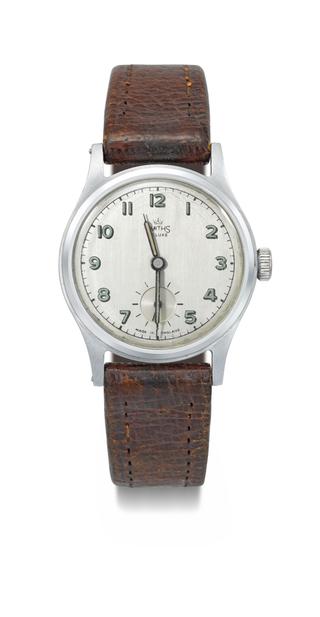
Smiths De Luxe Wristwatch Worn by Sir Edmund Hillary on His Ascent of Mount Everest 1953
1953
Wristwatch by Smiths English Clocks Ltd, Cheltenham, England, 1953. Steel waterproof case by the Dennison Watch Case Co, marked on the back 'AQUATITE, DENISTEEL BACK, 73359, CASE MADE IN ENGLAND' around 'DQ' in the centre. Silvered dial with Arabic numerals in luminous paint, and a subsidiary seconds dial at six o'clock. Signed ‘Smiths De Luxe' below twelve o'clock, and 'made in England' below the subsidiary dial. 15 jewel lever-escapement movement.
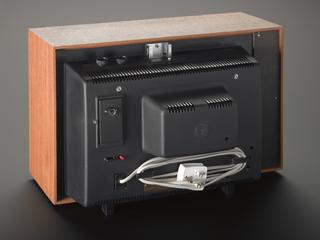
Sony 'Trinitron' Colour Television, 1969-1970
1969-1970
Sony 'Trinitron' colour television set, model type KV-1320UB, manufactured by Sony, Japan, 1969-1970. Serial No. 505704
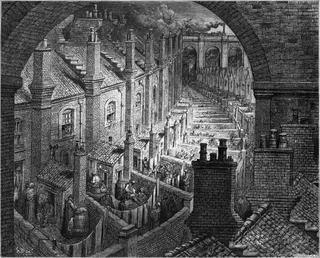
'Over London-by Rail', Engraving, London, England, 1872
1872
Wood engraving from 'London: a pilgrimage', by Gustave Dore, 1872. Signed in the block blc: Over London - by Rail. Depicting [East End] tenements, washing in back gardens, chimney pots, railway in distance.

Motorola StarTAC mobile phone, 1997.
1997
STAR TAC mobile telephone by Motorola, Alencon Link, Basingstoke, Hampshire, 1997.
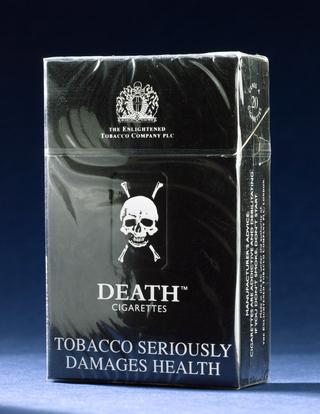
Packet of 20 Death Cigarettes, London, England, 1999
1999
Packet of 20 Death cigarettes, labelled: 'Manufacturer's advice: Cigarettes are addictive and debilitating. If you don't smoke, don't start. Death is a responsible way to market a legally available consumer product which kills people when used exactly as intended. Death cigarettes: For an honest smoke', made in the EC under the authority of The Enlightened Tobacco Company Plc, London, c.1999.

Section of a Boeing 747, 1973.
1973
Section of Boeing 747 foreward fuselage (cut from 747-SR-46 supplied to Japan Air Lines 21/12/73).
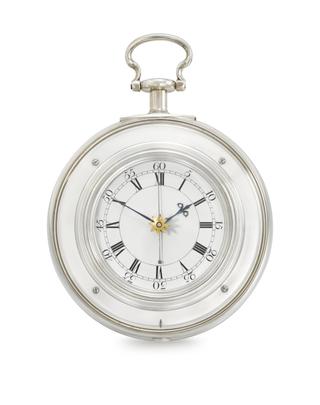
Marine Timekeeper known as 'H5' by John Harrison and Son 1770
1770
Silver pair-cased marine timekeeper, known as H5, by John Harrison & Son, London. White enamel dial with gold central star to adjust hands. Verge escapement with Harrison’s special diamond pallets. Steel balance and spring. Fusee. Maintaining power. 7 1/2 seconds remontoir on 4th wheel. All wheels from the 3rd, jewelled. Long bimetallic strip on adjustable frame. Original key and starting pin. Signed ‘John Harrison & Son London 1770 No. 2’. Case hallmarked for 1768 – 9 and stamped ‘HT’ (probably Henry Taylor who became a free Clockmaker in 1746). With original mahogany carrying case and three silk cushions.
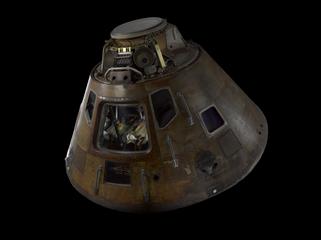
Apollo 10 Command Module, Call Sign 'Charlie Brown'
1969
Apollo 10 command module, call sign 'Charlie Brown', by North American Rockwell Corporation, Downey, California, United States, 1969. Apollo 10, carrying astronauts Thomas Stafford, John Young and Eugene Cernan, was launched in May 1969 on a lunar orbital mission as the dress rehearsal for the actual Apollo 11 landing. Stafford and Cernan descended in the Lunar Module to within 14 kilometres of the surface of the Moon, the closest approach until Neil Armstrong and Edwin ‘Buzz’ Aldrin in Apollo 11 landed on the surface two months later.
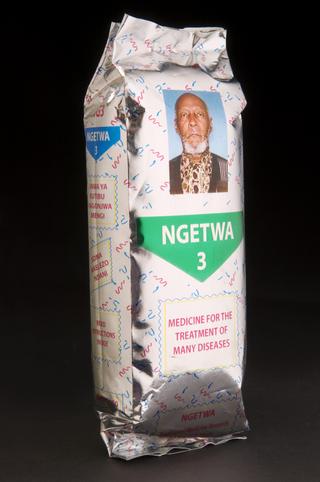
Ngetwa 3 herbal medicine
2005
Packet of Ngetwa 3 herbal medicine for 'the treatment of many diseases', Kyela, Tanzania, 2005
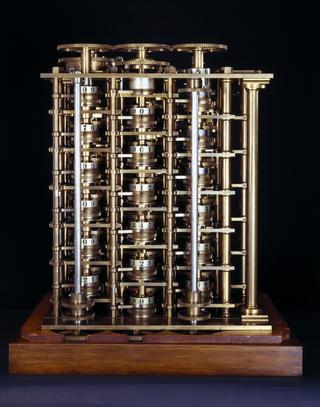
Difference Engine No. 1
circa 1832
Portion of Charles Babbage's calculating machine (Difference Engine No.1), built by Joseph Clement, London, 1832.
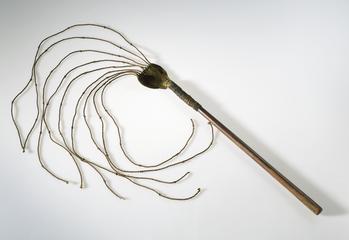
Cat-o-nine Tails, United Kingdom, 1700-1850
1700-1850
Cat o'nine tails, whip-cord with wooden handle, reputedly British Navy, 1700-1850
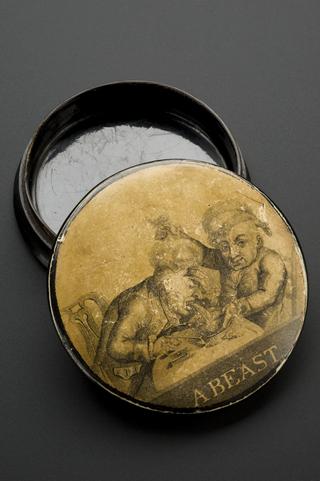
Snuff Box, England, 1771-1830
1771-1830
Papier mache snuff box, circular, detachable lid with sepia print entitled "A Beast" two late 18th century gentlemen at a table, one being sick due to too much smoking, English, 1771-1830
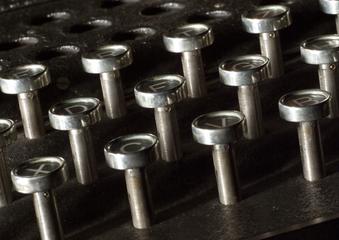
Three-ring Enigma cypher machine in oak wood transit case
1934
Three-ring Enigma cypher machine complete in oak wood transit case, together with original German battery (Serial number A6421/1937), unsigned, Germany, 1934 (see Note)
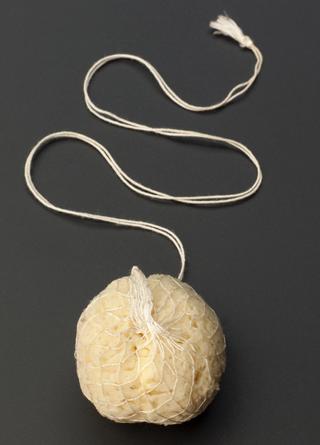
Contraceptive Sponge
1920-1960
Marine sponge, for use as vaginal pessary, possibly English, 1920-1960

Tracy, a transgenic sheep
1990-1997
Tracy, a transgenic ewe. Genetically modified to produce a human protein (alpha antitrypsin) in her milk, 1990-97.

Personal Computer, model Apple I
1976-1979
Personal Computer, model Apple I, devised by Steve Wozniak, Steve Jobs and Ron Wayne, and made by Apple Inc, United States, 1976-1979.

Cubical polyhedral sundial
1751-1800
German universal cubical sundial in wood with paper scales, signed D. Beringer, compass needle and cover glass missing, c.1780
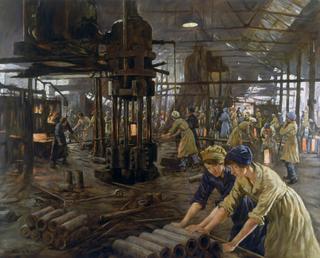
The Munition Girls
1918
Painting, [The Munition Girls] / by Stanhope Alexander Forbes, 1918. Oil on canvas; 40x 50" or 103x127cm, in decorative gilt frame 132x152x8.5cm. Signed and dated bottom left. Female operatives making 4.5-inch shells at the Kilnhurst Steel Works of John Baker and Co. Ltd., Rotherham; steel billets are re-heated in a separate furnace and, still glowing, moved by hand to a steam hydraulic press for forging. Mr. George Baker commissioned this scene "to produce a memento for our women workers", and each of them received a framed copy of it.
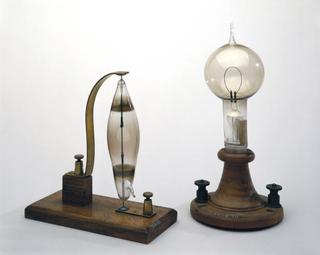
Swan electric lamp
1878-1879
Early carbon and rod filament incandescent electric lamp, by Sir Joseph Wilson Swan, England, 1878-1879
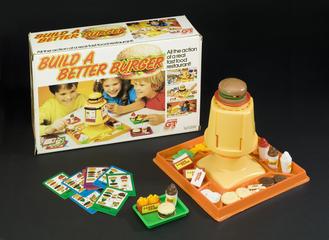
'Build a Better Burger' Game
1984-1986
Game, 'Build a Better Burger' game for 2-4 players ages 5 and over, marked 'All the action of a real fast food restaurant!', made by Action Games and Toys Ltd, Henley-on-Thames, Oxfordshire, under license from Lakeside Games (a division of Leisure Dynamic Inc, Minneapolis, Minnesota, USA), 1984-1986. Players compete to be the first to assemble a meal according to the menu card they select.
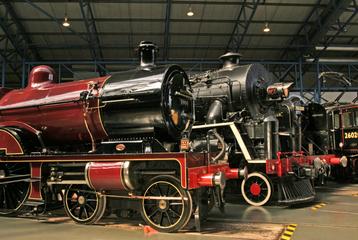
Chinese Government Railways Steam Locomotive 4-8-4 KF Class No 7
1935
Steam locomotive KF class number 7, 4-8-4, Chinese Government Railways, designed by Colonel Kenneth Cantlie, built by Vulcan Foundry in 1935 (as number 607), withdrawn in 1981.
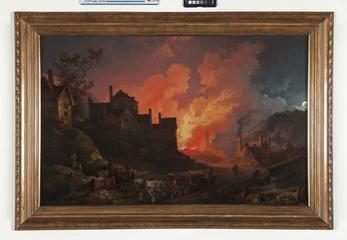
Coalbrookdale by Night by Philippe Jacques de Loutherbourg
1801
Coalbrookdale by Night by Philippe Jacques de Loutherbourg, 1801. Oil on canvas in gilt frame. Signed and dated bottom right. Exhibited as 'A View of Colebrook Dale by night' at the Royal Academy London in 1801. It shows the Bedlam furnaces at Coalbrookdale in Shropshire, with flames and smoke billowing from the centre of the picture. The picturesque gorge landscape to either side is lit by moonlight, and figures hurry in the foreground to transport raw materials and iron pigs.
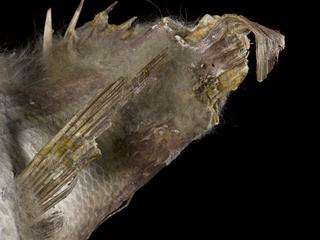
'Merman'
1801-1900
Dried merman, possibly Dutch or Japanese, possibly a Javanese ritual figure, possibly 1850-1900.
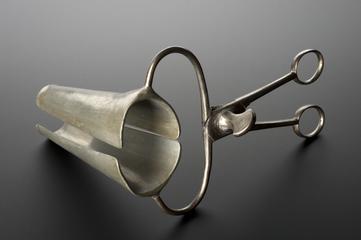
Vaginal Speculum for Applying Leeches
1801-1830
Guilbert vaginal speculum, metal, French, 1801-1830.

Empty bottle for Opium tincture tablets
1880-1940
Glass bottle with cork stopper for Tabloid brand Opium Tincture (laudanum) tablets, now empty. 76 mm x 34 mm x 23 mm, .03kg. Made by Burroughs Wellcome, English, second half 19th century.

Southern Railway 0-6-0 Q1 class steam locomotive, No C1
1942
Steam locomotive, No C1, Q1 Class, 0-6-0, Southern Railway, designed by O V Bulleid, built at Brighton in 1942, withdrawn in 1964. Weight: 51.25 tons; length 54 feet, 10 ½ inches; driving wheel diameter: 5 feet, 1 inch
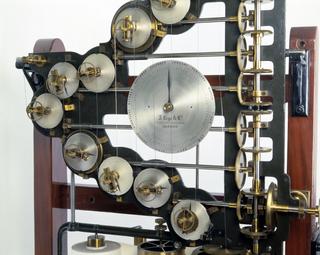
William Thomson's Tide Predicting Machine, 1872
1872
Tide-predicting machine designed by William Thomson (later Lord Kelvin), built by A. Légé & Co., 20 Cross Street, Hatton Gardens, London, 1872. The machine is a mechanical analogue computer which traces the tidal curve for a given location, by combining ten astronomical components. It is the first working machine of Thomson’s design, based on his application of harmonic analysis to tidal phenomena.

Small orrery by Benjamin Martin
1738-1777
Small orrery on mahogany stand by Benjamin Martin, England, mid-18th century. The orrery shows seven planets (to Uranus), but Uranus is thought to be a later addition.

Strowger automatic telephone, 1901-1910
1901-1910
Strowger table pattern telephone, manufactured by the Automatic Electric Company, Chicago, United States, 1901-1910
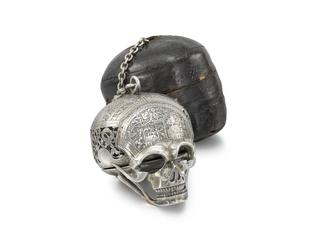
'Memento mori' watch in the form of a skull, known as the 'Mary Queen of Scots' watch.
1780-1850
Watch signed Moysant, Blois in the shape of a skull, with outer leather travel case. The large silver case is shaped like a human skull and is pierced and also engraved all over with religious and mythological scenes as well as quotations in Latin from Horace. The mechanism, which includes a striking train, is hidden inside the skull. It has had considerable alteration and is now a conversion to lever escapement. The silver dial, which has two hands, is engraved with a scene of Saturn swallowing his children.
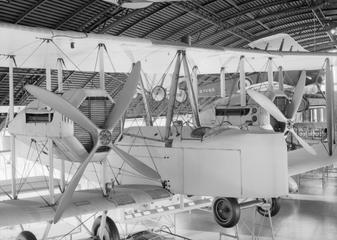
Alcock and Brown's Vickers Vimy Biplane
1919
Alcock and Brown's Vickers Vimy biplane.

Obsidian possibly used in trephination experiments
1918-1920
One piece of obsidian, possibly used as trephining instrument by Dr. T. Wilson Parry, in experiments on neolithic trephination, England, 1918-1920
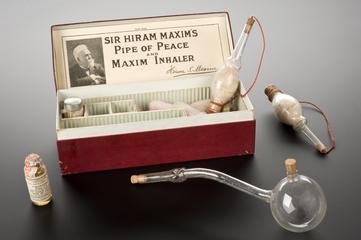
Maxim's 'Pipe of Peace', 1909-1910
1909-1910
One of two boxed sets of Maxim's inhaler, Sir Hiram Maxims "Pipe of Peace", with drug prepared by John Morgan Richards and Sons Ltd., London, 1909-1910

Rotative Steam Engine by Boulton and Watt, 1788
1788
Boulton and Watt Rotative Beam Engine - the 'Lap' engine. This is the oldest essentially unaltered rotative engine in the world. Built by James Watt in 1788, it incorporates all of his most important steam-engine improvements. The engine was used at Matthew Boulton’s Soho Manufactory in Birmingham, where it drove 43 metal polishing (or ‘lapping’) machines for 70 years.

Motorola 'GSM flare' mobile telephone, 1995
1995
Motorola GSM flare mobile phone, type 6200, made by Motorola, British, 1995. Pack no. S4647BBBB
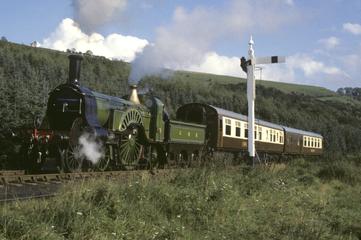
Great Northern Railway 4-2-2 locomotive Stirling Single
1870
Steam locomotive and tender, Great Northern Railway, 4-2-2 No 1, designed by Patrick Stirling, built at Doncaster in 1870, withdrawn in 1907.
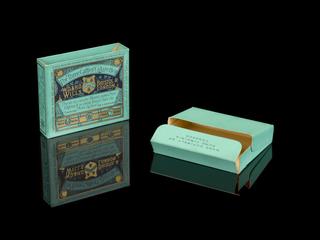
Packet of 20 'Three Castles' cigarettes
1920-1950
Packet of 20 'Three Castles' cigarettes, manufactured by W D and H O Wills Limited, Bristol, England, 1920-1950

Foucault Pendulum for Demonstrating the Earth's Rotation
1988
Foucault pendulum designed by A.B. Pippard and built at the Cavendish Laboratory, Cambridge, including suspension, sustaining mechanism and bob
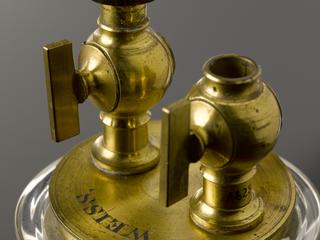
Early inhaler for ether anaesthesia
1847-1848
Early inhaler for ether anaesthesia, ether bottle connected by tubing to face mask, by Weiss of London, 1847-1848
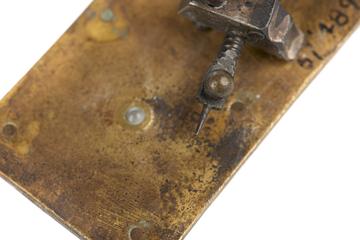
Model of Leeuwenhoek's microscope
1901-1930
Model of Leeuwenhoek's simple microscope, from Leyden
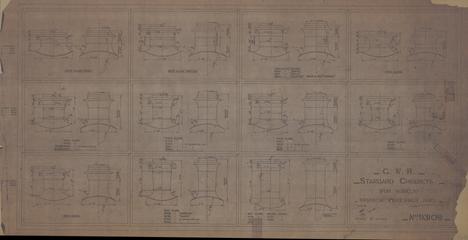
Swindon Works Drawings
1060 boxes